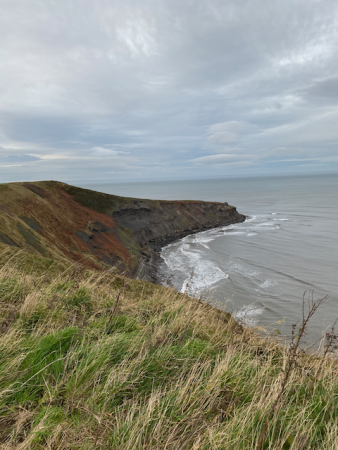
The tiny fishing village of Staithes is a place of peaceful beauty. It lies part way between Whitby and Saltburn on the North Yorkshire coast. It’s geology is also one of the few breaks in the vast cliffs that define this region; and which are the main source of the famous Whitby Jet semi-precious stone.

Staithes was our destination… and I was taking a calculated risk in order to give us a dramatic contrast to the morning. The visit to the Abbey – to recreate in our own minds the seismic events of AD664 – had been intense. At the conclusion of the synod, Bishop Colman had known that his world was over; that the new age of Christianity would follow the Church of Rome model. He took his followers and walked out of the Abbey, northwards.

We can never know the emotion that flowed between Bishop Colman, King Oswiu (who was, until that point, a Celtic Christian) and the two facilitators of the synod, Bishop Cedd and Abbess Hild, but we can know that it did exist, and that as wise and experienced a king as Oswiu would not have acted without being aware of the consequences – including the impact on the holy island of Lindisfarne…
Symbolically, the group of us walking against the keen winds on the cliffs beyond Port Mulgrave had as little a choice as had Bishop Colman, walking away from Whitby – but our predicament was brief – whereas his changed the rest of his life.
We had been dropped off a Mulgrave… our only refuge would be to get to Staithes. Our risk was not great. The weather has been kind: windy but not too cold. December on the high Cleveland Way can be very different…

Development of the Cleveland Way began in the 1930s when the Teesside Ramblers’ Association pressed for the creation of a long distance path in the north-east of Yorkshire linking existing paths along the boundaries of the North York Moors and footpaths on the Yorkshire coast.

A formal proposal to create the route was submitted in 1953 to the council North Riding of Yorkshire, by the National Parks Commission. In 1969, the path was finally opened – only the second of its kind in the UK.
Our problem was not the cold. It was the light. The path was muddier than we had expected and progress towards Staithes was slow. At an open place where the views of the coast fell away on either side, we stopped for our final exercise of the day. Once again, we revisited the sequence of four words we had each selected at the opening meal. By now, we knew each ‘pointed’ to a process whereby we could bring to consciousness one related set of psychological obstacles to our spiritual growth.
Flattery – Pride – Humility – Will
Facing the wind off the sea, we each voiced how our words could be seen as one of the keys of inner transformation.

With the light beginning to fade, we came down from the cliff path and onto the flat agricultural land that borders the upper village of Staithes.

Below us, the lights of Staithes were twinkling.
A ‘staithe’ is an old English word meaning ‘landing place’. The plural name “Staithes” of the fishing port is due to its twin ‘landing places’; one on each side of the stream that flows down from the moor and into the sea- named Roxy Beck.

Staithes was once one of the largest fishing ports on the north-east coast. It was also an important source of minerals such as jet, iron, alum and potash. These days, the huddle of cottages nestled between towering cliffs is an attractive holiday destination and lies within the North York Moors National Park.
The village is famous as a source of inspiration for artists, in particular the impressionist artist colony known as the Staithes Group, among them Laura and Harold Knight. The quality of light and the variety of perspectives offered by cliff-top views and winding paths have made Staithes a magnet for artists.

The risk had been worth it. We arrived at our destination just as a gentle darkness fell. We had picked the Cod and Lobster tavern on the main quayside as a meeting point. Those who had been unable to make the walk met us there. After the intensity of the day, we needed simple refreshment. Tomorrow would be a challenging day.

To be continued…
Other parts in this series of posts: Part One Part Two Part Three Part Four Part Five Part Six This is Part Seven
©Stephen Tanham 2020
Stephen Tanham is a Director of the Silent Eye School of Consciousness, a not-for-profit teaching school of modern mysticism that helps people find a personal path to a deeper place within their internal and external lives.
The Silent Eye provides home-based, practical courses which are low-cost and personally supervised. The course materials and corresponding supervision are provided month by month without further commitment.
Steve’s personal blog, Sun in Gemini, is at stevetanham.wordpress.com.



























A wonderful day, Steve. This area is fascinating.
LikeLiked by 1 person
Thank you, Robbie. There is so much to see, and the variety of experience is wonderful. That ‘palette’ of potential moods is perfect for a workshop.
LikeLike
Pingback: Keys of Heaven (8): crosses at heaven's gate – Sun in Gemini
Pingback: Keys of Heaven (9): blown down the mountain – Sun in Gemini
Pingback: Keys of Heaven (9): blown down the mountain – The Silent Eye
Pingback: Keys of Heaven (10): A Final Resting Place – The Silent Eye
Pingback: Keys of Heaven (10): final resting place… – Sun in Gemini